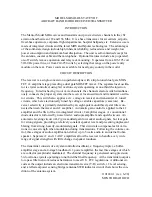
1101242-3
(rev.
6-98)
MENTOR
RADIO
CO.
MODEL MB VHF AIRCRAFT BAND
RADIO RECEIVER/TRANSMITTER
OPERATION
The Model MB is turned
on
and
off
by the rocker switch near the lower right corner of the
MB front panel. When the MB is
on
the green lamp built into the switch will light.
The volume control knob (marked VOL) adjusts speaker loudness to the level preferred by
the operator. Since the on-off switch is not combined with the volume control, the volume
setting may be left unchanged when the radio is turned off. The volume control does not
affect transmitter operation.
The squelch control allows the operator to eliminate undesirable receiver background noise
when no signal is being received. Turning the knob (marked SQ) fully counterclockwise
“unsquelches” the receiver, allowing background noise and very weak signals to be heard.
Some operators may prefer to leave the receiver unsquelched at all times. For those who
prefer to use the squelch, periodic unsquelching can serve as a receiver test, since a large
reduction in background noise might indicate receiver malfunction. To squelch the back-
ground noise, rotate the SQ control clockwise only as far as necessary to just stop the
noise. Further rotation may result in not hearing more distant aircraft. There may be some
circumstances in which an operator does not wish to hear more distant aircraft, such as
when such aircraft are communicating with a different ground station. In this situation the
control may be rotated fully clockwise. The squelch control does not affect transmitter
operation.
The signal strength meter (S-meter) is useful for checking receiver sensitivity and the rela-
tive strengths of aircraft transmitters whose positions are known. For example, if several
aircraft at a specific ramp or taxiway position produce S-20 readings, while another pro-
duces only S-3, the latter's transmitter or antenna is probably not operating properly. Simi-
larly, if most aircraft calling “5 miles out” produce an S-7 reading, another aircraft there
that barely moves the S-meter needle probably has a poor transmitter or antenna. How-
ever, if an aircraft calls and produces a good meter deflection (S-3 or higher) yet sounds
weak, the aircraft’s transmitter is producing a good carrier signal but has poor modulation
(perhaps from a bad microphone). The S-meter can also be used to study the effects of
shadowing of the base station antenna due to nearby buildings, structures, terrain, etc., by
having a cooperating aircraft fly a constant radius circle around the airport and calling at
different locations. If the Model MB receiver is working properly and the operator is fa-
miliar with “average” S-meter readings for aircraft at various distances, then the meter can
be used as a crude indicator of the aircraft’s distance from the station. The S-meter can
also suggest loss of Model MB receiver sensitivity, if the readings from all aircraft become
“less than usual”. Intelligent and thoughtful observations of the S-meter can often suggest
the causes of communications problems.
1101242-4
(rev.
6-98)

























